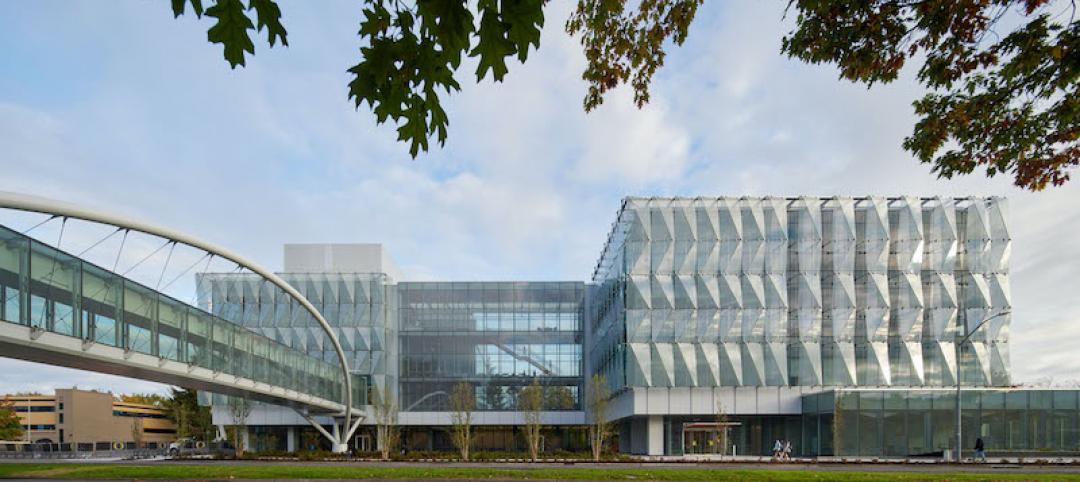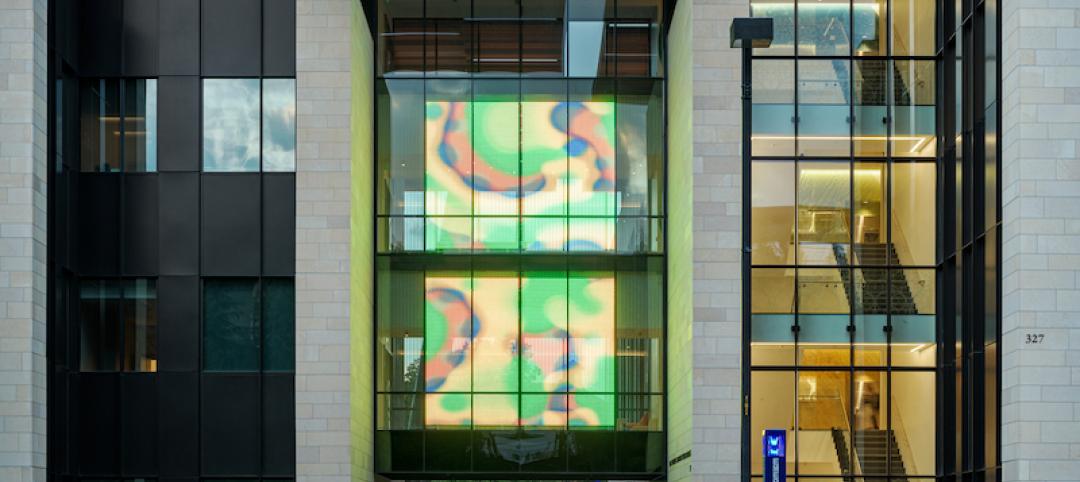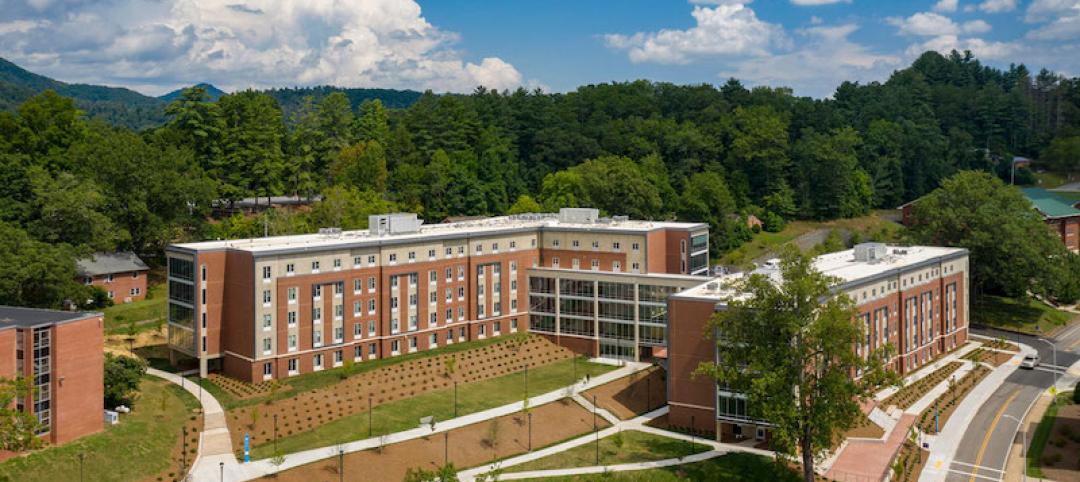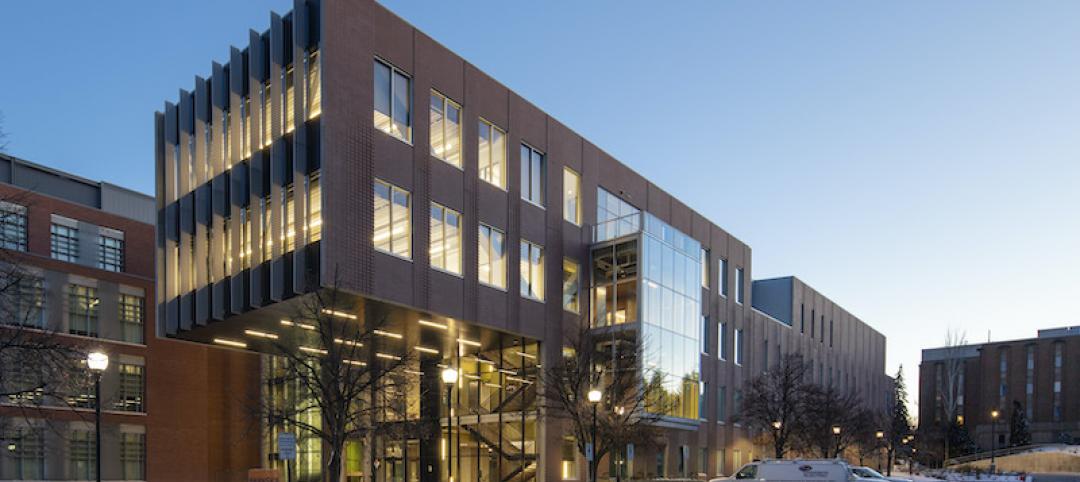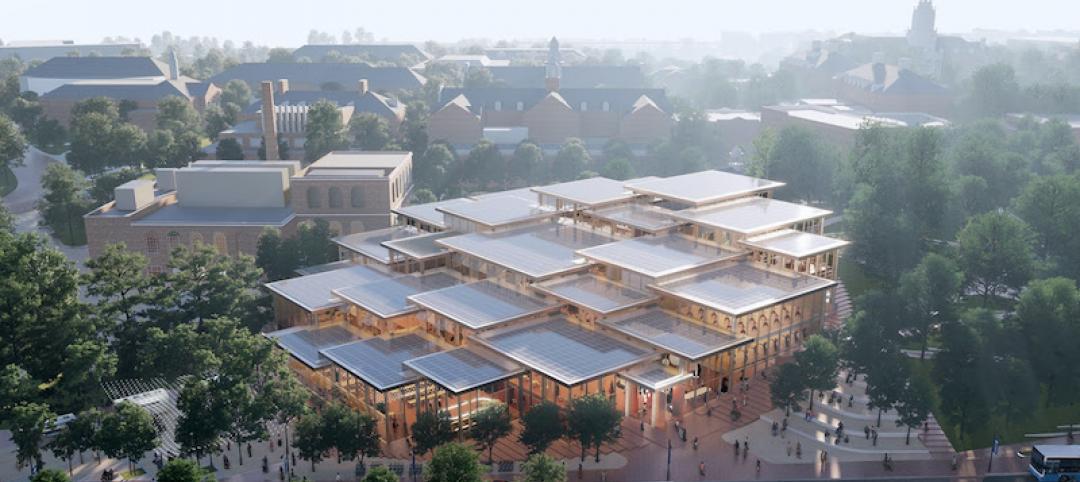On Monday, Columbia University held a dedication ceremony for its 17-acre Manhattanville campus in the West Harlem section of New York City. This $6.3 billion campus, which when completed will comprise 6.8 million sf of new academic space, is the university’s most ambitious expansion since it relocated to its current campus at Morningside Heights in Harlem 119 years ago.
The new campus, which was master planned by Skidmore Owings & Merrill and Renzo Piano Building Workshop, has been in the works since 2003, roughly around the time Lee C. Bollinger became the university’s president. “We knew that Columbia had to have new space to fulfill its mission as a great university,” said Bollinger during the dedication’s luncheon, held inside the 450,000-sf Jerome L. Greene Science Center, Manhattanville’s first building to open.
The Center, which should be fully occupied by next spring, is home to the Mortimer B. Zuckerman Mind Brain Behavior Institute. (The publisher and philanthropist Mort Zuckerman; Christina McInerney, president and CEO of the Jerome L. Greene Foundation; three Nobel Prize laureates and two Pulitzer Prize winners were among the dignitaries in attendance.)
Over the next two years, the Manhattanville campus will open the 60,000-sf Lenfest Center for the Arts, which will feature the Miriam and Ira D. Wallach Art Gallery, a 150-seat screening room, and a 4,300-sf presentation space; and the 56,000-sf University Forum, with a 430-seat auditorium.
Eric Kandel, MD, co-director of the Zuckerman Mind Brain Institute (and a Nobel Laureate in 2002 for the category physiology or medicine), proclaimed this project “historically important” to the university’s stature as well as for accentuating the symbiosis on campus between “bioscience and the arts.”
By 2021, the Ronald O. Perlman Center for Business Innovation and the Henry Kravis Building—492,000 sf across two buildings designed by Diller Scofidio + Renfro in collaboration with FXFowle Architects—will be the new home for the Columbia Business School.
Architect Renzo Piano describes the Jerome L. Greene Science Center in relation to its surrounding environment, which includes New York City's West Side Highway and the Hudson River. Image: BD+C
Architect Renzo Piano spoke at the dedication, at which he referred to the Jerome L. Greene Science Center as both a “palace” and a “factory that explores the secrets of the mind.” Piano also talked about the “urban layer” that will connect the campus to the community via reversed ground-floor setbacks, widened sidewalks, the absence of walls or gates (which is in marked contrast to the fortress-like Morningside Heights campus), height limitations (the Center is nine stories above ground), and a custom-glazed curtainwall.
His firm designed the Center to be as transparent as possible. The facility’s first floor, in fact, is open to the public. And its offices, labs, and other workspaces are organized on an open floor plan, divided into quadrants along North-South/East-West axes that expose workers and visitors to ample daylight.
Jerome L. Greene Science Center is across the street from an elevated subway line whose noise level measures 88 decibels. To mitigate that noise, the building was designed with a double-pane glass wall system whose 16-inch-wide air cavity in between exhausts air from the HVAC system and lets occupants open windows and glass doors from the inside. Open-air staircases connect the floors and encourage interaction between departments.
A 75,000-sf central energy plant, beneath the Greene and Lenfest buildings, will deliver electricity, chilled water, and high-pressure steam to nearly all of the buildings on campus.
The exterior bracing is visible to call attention to Greene’s “industrial” affinity with surrounding buildings in the neighborhood. That connection is reinforced by Columbia’s adaptive reuse of existing buildings on Manhattanville’s campus—specifically a one-time Studebaker auto-manufacturing plant and milk processing plant—that now serve, respectively, as university administration offices and Columbia’s center for the study of jazz and computer-generated music.
Manhattanville was the original name of this neighborhood, and Columbia and its AEC partners are at great pains to position this campus expansion as integral to a community that in the past has been wary about the university’s growth intentions. Bollinger, in his comments, went so far as to state that the new campus “is the best thing that could happen to upper Manhattan.”
Outdoor plazas within the campus will be accessible to the general public. The Jerome L. Greene Science Center will include a 1,920-sf Wellness Center that conducts free programs to raise awareness about stroke and related risk factors, and trains local residents to become community health workers. The Wellness Center will also be home to Mental Health First Aid, a program dedicated to improving the quality of mental health services in Upper Manhattan.
A 1,500-sf Education Lab within the Center will provide programs about brain science for the community and K-12 schools. Columbia has contracted with BioBus, an independent nonprofit, to run this program, and to bring learning into the community.
“This campus puts Columbia into the world,” observed Marilyn Jordan Taylor, a consulting partner with SOM (where she spent 33 years) and the former dean of the University of Pennsylvania’s School of Design.
Columbia|Manhattanville’s buildings are targeting LEED Platinum ND certification. Lendlease and McKissack Construction are the construction managers on the Greene and Lenfest buildings, Skanska and Velez Organization are the CMs on the University Forum building. And Turner will be the CM on the business school.
Related Stories
Giants 400 | Dec 16, 2020
Download a PDF of all 2020 Giants 400 Rankings
This 70-page PDF features AEC firm rankings across 51 building sectors, disciplines, and specialty services.
University Buildings | Dec 13, 2020
U. of Oregon’s new Knight Campus is set up to turn ideas into reality
Its design encourages occupant productivity and well-being.
Giants 400 | Dec 3, 2020
2020 Science & Technology Facilities Giants: Top architecture, engineering, and construction firms in the S+T sector
HDR, Jacobs, and Turner head BD+C's rankings of the nation's largest science and technology (S+T) facilities sector architecture, engineering, and construction firms, as reported in the 2020 Giants 400 Report.
Giants 400 | Dec 2, 2020
2020 University Giants: Top architecture, engineering, and construction firms in the higher education sector
Gensler, AECOM, and Turner Construction top BD+C's rankings of the nation's largest university sector architecture, engineering, and construction firms, as reported in the 2020 Giants 400 Report.
University Buildings | Nov 25, 2020
Stanford bioresearch quad's new public art piece, “Morphogenesis”
Stanford University's Morphogenesis installation connects user interaction with a large-scale media mesh platform.
University Buildings | Nov 20, 2020
Why precast concrete is an appealing choice for student housing
A variety of material solutions are emerging to accelerate construction timelines, and precast concrete has become an attractive option.
Laboratories | Nov 16, 2020
Washington State University’s new Plant Sciences Building opens
LMN Architects designed the project.
AEC Tech | Nov 12, 2020
The Weekly show: Nvidia's Omniverse, AI for construction scheduling, COVID-19 signage
BD+C editors speak with experts from ALICE Technologies, Build Group, Hastings Architecture, Nvidia, and Woods Bagot on the November 12 episode of "The Weekly." The episode is available for viewing on demand.
University Buildings | Nov 5, 2020
BIG selected to design new Student Center for Johns Hopkins University
The new center will become the heart of the university’s campus.
Smart Buildings | Oct 26, 2020
World’s first smart building assessment and rating program released
The SPIRE Smart Building Program will help building owners and operators make better investment decisions, improve tenant satisfaction, and increase asset value.




